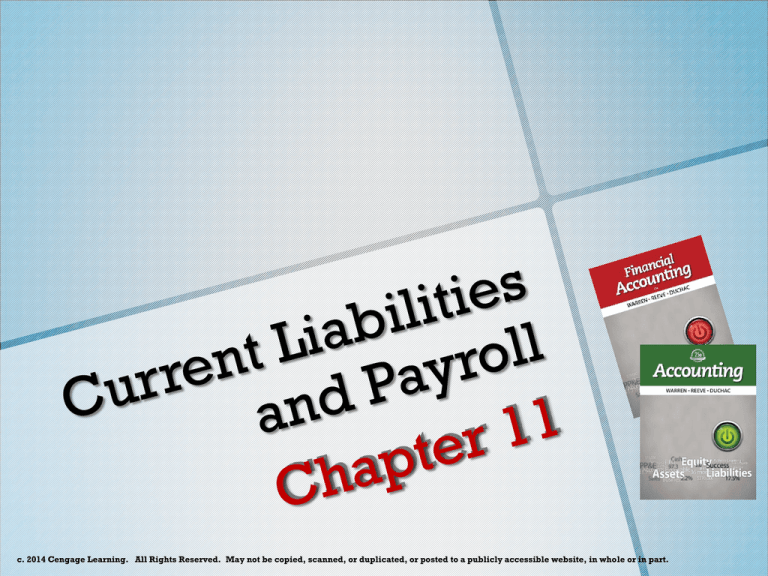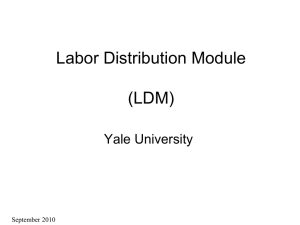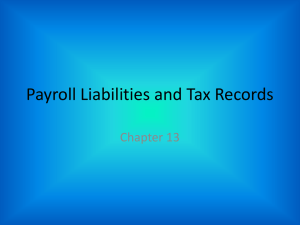
c. 2014 Cengage Learning. All Rights Reserved. May not be copied, scanned, or duplicated, or posted to a publicly accessible website, in whole or in part.
Learning Objectives
1.
Describe and illustrate current liabilities
related to accounts payable, current portion of
long-term debt, and notes payable.
2.
Determine employer liabilities for payroll,
including liabilities arising from employee
earnings and deductions from earnings.
3.
Describe payroll accounting systems that use
a payroll register, employee earnings records,
and a general journal.
Learning Objectives
4.
Journalize entries for employee fringe
benefits, including vacation pay and
pensions.
5.
Describe the accounting treatment for
contingent liabilities and journalize entries for
product warranties.
6.
Describe and illustrate the use of the quick
ratio in analyzing a company’s ability to pay
its current liabilities.
c. 2014 Cengage Learning. All Rights Reserved. May not be copied, scanned, or duplicated, or posted to a publicly accessible website, in whole or in part.
Current Liabilities
o
When a company or a bank advances credit, it
is making a loan.
o
The company or bank is called a creditor (or
lender).
o
The individuals or companies receiving the
loans are called debtors (or borrowers).
Current Liabilities
o Long-term liabilities are debts due beyond one
year.
o Current Liabilities are debts that will be paid
out of current assets and are due within one
year.
Accounts Payable
o
Accounts payable transactions arise from
purchasing goods or services for use in a
company’s operations or from purchasing
merchandise for resale.
ACCOUNTS PAYABLE
Current Portion of Long-Term Debt
o
Long-term liabilities are often paid back in
periodic payments, called installments.
Installments that are due within the coming
year must be classified as a current liability.
The installments due after the coming year are
classified as a long-term liability.
Short-Term Notes Payable
o Nature’s Sunshine Company issues a 90-day,
12% note for $1,000, dated August 1, 2011 to
Murray Co. for a $1,000 overdue account.
Short-Term Notes Payable
o When the note matures, the entry to record the
payment of $1,000 plus $30 interest ($1,000 x
12% x 90/360) is as follows:
Interest Expense appears
on the income statement
as an “Other Expense.”
Short-Term Notes Payable
o On May 1, Bowden Co. (borrower) purchased
merchandise on account from Coker Co.
(creditor), $10,000, 2/10, n/30. The
merchandise cost Coker Co. $7,500.
SHORT-TERM
NOTES PAYABLE
Bowden Co. (Borrower)
Description
Debit
Credit
Mdse. Inventory
10,000
Accounts Payable
10,000
Coker Co. (Creditor)
Description
Debit
Credit
Accounts Receivable 10,000
Sales
10,000
Cost of Mdse. Sold
Mdse. Inventory
7,500
7,500
Short-Term Notes Payable
o On May 31, Bowden Co. issued a 60-day, 12%
note for $10,000 to Coker Co. on account.
SHORT-TERM
NOTES PAYABLE
Bowden Co. (Borrower)
Description
Accounts Payable
Notes Payable
Debit
Credit
10,000
10,000
Coker Co. (Creditor)
Description
Debit
Credit
Notes Receivable
10,000
Accounts Receivable
10,000
Short-Term Notes Payable
o On July 30, Bowden Co. paid Coker Co. the
amount due on the note of May 31, the face
amount of $10,000 plus interest of $200
($10,000 x 12% x 60/360).
SHORT-TERM
NOTES PAYABLE
Bowden Co. (Borrower)
Description
Debit
Notes Payable
Interest Expense
Cash
10,000
200
Credit
10,200
Coker Co. (Creditor)
Description
Cash
Interest Revenue
Notes Receivable
Debit
Credit
10,200
200
10,000
Short-Term Notes Payable
o On September 19, Iceburg Company borrowed
cash from First National Bank by issuing a
$4,000, 90-day, 15% note to the bank.
Short-Term Notes Payable
o On December 18, Iceburg Company paid First
National Bank $4,000 plus interest of $150
($4,000 x 15% x 90/360).
Short-Term Notes Payable
o A discounted note has the following
characteristics:
The interest rate on the note is called the discount
rate.
The amount of interest on the note, called the
discount, is computed by multiplying the discount
rate times the face amount of the note.
The debtor (borrower) receives the face amount of
the note less the discount, called the proceeds.
The debtor must repay the face amount of the note
on the due date.
Short-Term Notes Payable
o On August 10, Cary Company issues a $20,000,
90-day discounted note to Western National
Bank. The discount rate is 15%, and the amount
of the discount is $750 ($20,000 x 15% x
90/360).
proceeds
Short-Term Notes Payable
o The entry when Cary Company pays the
discounted note on November 8 is as follows:
c. 2014 Cengage Learning. All Rights Reserved. May not be copied, scanned, or duplicated, or posted to a publicly accessible website, in whole or in part.
Payroll and Payroll Taxes
o
In accounting, payroll refers to the amount
paid to employees for services they provided
during the period. A company’s payroll is
important for the following reasons:
Payroll and related payroll taxes significantly
affect the net income of most companies.
Payroll is subject to federal and state
regulations.
Good employee morale requires payroll to be
paid timely and accurately.
Liability for Employee Earnings
o
Salary usually refers to payment for
managerial and administrative services.
Salary is normally expressed in terms of a
month or a year.
Liability for Employee Earnings
o Wages usually refers to payment for employee
manual labor. The rate of wages is normally
stated on an hourly or weekly basis.
(concluded)
Liability for Employee Earnings
o John T. McGrath is employed by McDermott
Supply Co. at the rate of $34 per hour, plus 1.5
times the normal hourly rate for hours over 40
per week. For the week ended December 27,
McGrath worked 42 hours. His earnings are
computed as follows:
Earnings at regular rate (40 x $34)
Earnings at overtime rate (2 x $51)
Total earnings
$1,360
102
$1,462
Deductions from Employee Earnings
o
The total earnings of an employee for a
payroll period, including any overtime pay,
are called gross pay.
o
From this amount is subtracted one or more
deductions to arrive at the net pay.
DEDUCTIONS FROM
EMPLOYEE
EARNINGS
Deductions from Employee Earnings
o John T. McGrath made $1,462 for the week
ending December 27. McGrath’s W-4 (previous
slide) claims one withholding allowance of $70.
Thus, the wages used to determine McGrath’s
withholding bracket in Exhibit 3 (next slide)
are $1,392 ($1,462 – $70).
DEDUCTIONS FROM
EMPLOYEE
EARNINGS
Deductions from Employee Earnings
o
The Federal Insurance Contributions Act
(FICA) tax withheld contributes to the
following two federal programs.
Social security, which provides payments for
retirees, survivors, and disability insurance.
(Assume 6% on all earnings.)
Medicare, which provides health insurance
benefits for senior citizens. (Assume 1.5% on all
earnings.)
Deductions from Employee Earnings
o John T. McGrath’s earnings for the week ending
December 27 are $1,462. Total FICA tax to be
withheld is calculated as follows:
Earnings subject to 6%
social security tax
$1,462
Social security tax rate
x
6%
Social security tax
$ 87.72
Earnings subject to 1.5% Medicare tax
$1,462
Medicare tax rate x 1.5% Medicare tax
21.93
$109.65
Total FICA tax
Computing Employee Net Pay
o John T. McGrath’s Net Pay
Liability for Employer’s Payroll Taxes
o
Employers are subject to the following payroll
taxes for amounts paid their employees:
FICA Tax
Federal Unemployment Compensation Tax (FUTA)
State Unemployment Compensation Tax (SUTA)
LIABILITY FOR
EMPLOYER’S
PAYROLL TAXES
c. 2014 Cengage Learning. All Rights Reserved. May not be copied, scanned, or duplicated, or posted to a publicly accessible website, in whole or in part.
Accounting Systems for Payroll and Payroll Taxes
o
Payroll systems should be designed to:
Pay employees accurately and timely.
Meet regulatory requirements of federal, state, and
local agencies.
Provide useful data for management decision-
making needs.
Payroll Register
o
The payroll register is a multicolumn report
used for summarizing the data for each
payroll period. Exhibit 5 illustrates a payroll
register for McDermott Supply Co.
PAYROLL REGISTER
(left side, continued)
PAYROLL REGISTER
(right side)
RECORDING
EMPLOYEES’
EARNINGS
Recording and Paying Payroll Taxes
o Employers must match the employee’s social
security and Medicare tax contributions. In
addition, the employer must pay SUTA tax of
5.4% and FUTA tax of 0.8% (assume on
$2,710). For McDermott Supply’s payroll of
December 27, these payroll taxes are
computed as follows:
Social security tax
Medicare tax
SUTA
FUTA
Total payroll taxes
$ 834.12
208.53
146.34
21.68
$1,210.67
($13,902 x 6%)
($13,902 x 1.5%)
($2,710 x 5.4%)
($2,710 x 0.8%)
Recording and Paying Payroll Taxes
o The entry to journalize the payroll tax expense
for Exhibit 5 is shown below.
Employee’s Earnings Record
o
A detailed payroll record must be kept for
each employee. This record is called an
employee’s earnings record. Exhibit 6 (next
two slides) shows a portion of John T.
McGrath’s employee’s earnings record.
EARNINGS RECORD
EARNINGS RECORD
EMPLOYEE’S
EARNINGS RECORD
Payroll Checks
o
At the end of each payroll period, payroll
checks are prepared. Each check includes a
detachable statement showing the details of
how the net pay was computed.
PAYROLL CHECK
Payroll System Design
o The inputs into a payroll system may be
classified as:
Constants, which are data that remain unchanged
from payroll to payroll.
• Employee names
• Social security numbers
Variables, which are data that change from payroll to
payroll.
• Number of hours or days worked
• Accrued sick leave
Internal Controls for Payroll Systems
o
Some examples of payroll controls include the
following:
If a check-signing machine is used, blank payroll
checks and access to the machine should be
restricted to prevent their theft or misuse.
The hiring and firing of employees should be
properly authorized and approved in writing.
(continued)
Internal Controls for Payroll Systems
All changes in pay rates should be properly
authorized and approved in writing.
Employees should be observed when arriving for
work to verify that employees are “checking in” for
work only once and only for themselves.
Payroll checks should be distributed by someone
other than employee supervisors.
A special payroll bank account should be used.
(continued)
c. 2014 Cengage Learning. All Rights Reserved. May not be copied, scanned, or duplicated, or posted to a publicly accessible website, in whole or in part.
Employees’ Fringe Benefits
o
Many companies provide their employees
benefits in addition to salary and wages
earned. Such fringe benefits may include:
Vacation pay (sometimes called compensated
absences)
Medical benefits
Retirement benefits
Vacation Pay
o Assume that employees earn one day of
vacation for each month worked. The estimated
vacation pay for the year ending December 31
is $325,000. The adjusting entry for the
accrued vacation is shown below.
Pensions
o
A pension is a cash payment to retired
employees. Pension rights are accrued by
employees as they work, based on the
employer’s pension plan. Two types of pension
plans are:
Defined contribution plan
Defined benefit plan
Pensions
o In a defined contribution plan, the company
invests contributions on behalf of the
employee during the employee’s working
years.
Normally, the employee and employer contribute to
the plan.
The employee’s pension depends on the total
contributions and the investment returns earned on
those contributions.
Pensions
o Heaven Scent Perfumes Company contributes
10% of employee monthly salaries to an
employee 401K plan. Assuming $500,000 of
monthly salaries, the journal entry to record
the monthly contribution is shown below.
Pensions
o In a defined benefit plan, the employer is
obligated to pay for (fund) the employee’s
future pension benefits.
Many companies are replacing their defined benefit
plans with defined contribution plans.
A retired employee receives a specific amount
based on his or her salary history and years of
service.
Pensions
o The defined benefit plan of Hinkle Co. requires
an annual pension cost of $80,000. The annual
contribution is based on estimates of Hinkle’s
future pension liability. On December 31,
Hinkle Co. pays $60,000 to the pension fund.
The entry to record the payment and unfunded
liability is shown below.
Postretirement Benefits Other than Pensions
o
Employees may earn rights to other
postretirement benefits, such as dental care,
eye care, medical care, life insurance, tuition
assistance, tax services, and legal services.
CURRENT
LIABILITIES ON THE
BALANCE SHEET
c. 2014 Cengage Learning. All Rights Reserved. May not be copied, scanned, or duplicated, or posted to a publicly accessible website, in whole or in part.
Contingent Liabilities
o Some liabilities may arise from past
transactions if certain events occur in the
future. These potential obligations are called
contingent liabilities. The accounting for
contingent liabilities depends on the following
two factors:
Likelihood of occurring: Probable, reasonably
possible, or remote
Measurement: Estimable or not estimable
Contingent Liabilities
o During June, a company sold a product for
$60,000 that includes a 36-month warranty for
repairs. The average cost of repairs over the
warranty period is 5% of the sales price. The
entry to record the estimated product warranty
expense for June is shown below.
Contingent Liabilities
o If a $200 part is replaced under warranty on
August 16, the entry is as follows:
CONTINGENT
LIABILITIES
c. 2014 Cengage Learning. All Rights Reserved. May not be copied, scanned, or duplicated, or posted to a publicly accessible website, in whole or in part.
Quick Ratio
o
Current position analysis helps creditors
evaluate a company’s ability to pay its current
liabilities. It is based on:
Working capital, the excess of current assets over
current liabilities
Current ratio, determined by dividing the current
assets by the current liabilities
Quick ratio, an indicator of a company’s short-term
liquidity
Quick Ratio
o The quick ratio measures the “instant” debtpaying ability of a company and is computed
as follows:
Quick Assets
Quick Ratio =
Current Liabilities
o Quick assets are cash and other current assets
that can be easily converted to cash.
c. 2014 Cengage Learning. All Rights Reserved. May not be copied, scanned, or duplicated, or posted to a publicly accessible website, in whole or in part.


![[Product Name]](http://s2.studylib.net/store/data/005238235_1-ad193c18a3c3c1520cb3a408c054adb7-300x300.png)





